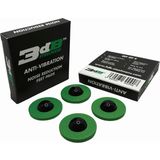Practical 3D Printing Accessories
These 5 items make 3D printing easier for you
There are numerous 3D printer accessories that are used for the operation and maintenance of FDM printers and for the post-processing of 3D models.
In addition to the indispensable basic equipment, i.e. the absolutely necessary accessories that you should always have at hand for 3D printing (tools, isopropyl alcohol, tweezers, etc.), we would like to introduce you to 5 items, without which you can work, but which you won't want to miss once you've used them.
1. Antclabs BLTouch - Automatic bed levelling sensor
The Antclabs automatic bed levelling system is the epitome of 'handy'! Provided you have a 3D printer without already integrated automatic levelling, the levelling sensor can easily be retrofitted on your 3D printer. Once used, you'll never want to go back to manual levelling.
Due to its compatibility with almost all 3D printers and the possibility of using it on all types of print bed surfaces, the automatic levelling sensor enjoys worldwide popularity and is an inexpensive upgrade for your 3D printer.
Here you can find more information about the automatic levelling sensor from Antclabs.
2. Magnetic flexible print surface from 3DJake - For better adhesion and easier removal
Everyone who deals with 3D printing knows the problem: you start printing and after a few minutes you notice that the print is not properly adhering to the print bed. The moment is even more bitter when you want to look at the result after hours of printing, but it is stuck to the platform and you simply cannot remove it. When trying to remove it with the spatula and hands, it is not uncommon for something to go wrong and all the work and patience was in vain.
In order to avoid this problem in a simple and uncomplicated way, we developed a magnetic flexible print surface that is easy to remove the printed piece simply by bending it. The surface was specially developed to ensure better adhesion than conventional build surfaces. After printing, the surface can easily be removed. By bending the flexible plate, the printed piece is effortlessly released - almost by itself.
Really nice: The flexible surface can be used universally and is compatible with every 3D printer. It is available in numerous sizes and can even be cut to a smaller size if required.
Here you can find out more about the magnetic flexible printing plate from 3DJake.
3. Polymaker Polybox - For optimal filament storage
The correct storage of the filaments is usually not one of the things that one deals with when getting started with 3D printing, but one should definitely deal with it in time, because: If filaments are not stored correctly, this can lead to printing problems and the materials are damaged or even unusable.
Most materials, especially nylon and PVA, will absorb water from the air over time. In fact, only one day in the air is enough for these filaments to completely “saturate” them. PLA and ABS also absorb water, not so quickly, but they do. PLA or ABS that is too moist can form bubbles when printing causing inconsistencies in flow or clogging the nozzle.
The ideal way to store your materials is, therefore, to keep them in a filament storage box with a thermo-hygrometer. In such a box, the filaments are stored airtight and protected from moisture. With the thermo-hygrometer, the temperature and humidity are always measured precisely.
We, therefore, recommend a filament storage box such as the Polymaker PolyBox especially to those who want to work with nylon, PVB or PVA. Two filament spools, each weighing one kilo or one 3kg spool, can be stored in the box. Since the filament can be fed through 6 exit holes, the box is compatible with almost all printers.
You can find out more about the Polymaker PolyBox here.
4. 3dB anti-vibration pads - For low-noise printing
A 3D printer can make loud noises due to vibrations from moving parts and motors. This vibration can be transmitted to other objects that come into contact with the 3D printer. The desk, shelf or workstation then acts as an amplifier for these unpleasant and annoying noises.
A really simple and effective solution to noise reduction is anti-vibration foot pads that isolate printer vibrations and thus significantly reduce noise. In addition to reducing noise, anti-vibration foot pads can even counteract print problems such as ghosting / ringing.
Especially when operating 3D printer farms with several devices, where the noise can be very annoying, we recommend anti-vibration foot pads such as those from 3dB.
You can find more information about the anti-vibration foot pads from 3dB here.
5. Cleaning filament from AprintaPro & nozzle cleaning set from 3DJake
If the nozzle of the 3D printer is clogged and can no longer be used, it can either be replaced or cleaned.
In the case of slight blockages, we recommend the use of cleaning filament, with which residues in the hotend are easily removed and the print quality is improved.
If the 3D printer nozzle is heavily clogged or dirty, it should be cleaned using nozzle needles. In our shop, you will find a practical cleaning set with nozzle needles, tweezers and copper brush, with which you can make your nozzle shine again in no time at all. With a diameter of 0.3 mm, these needles are suitable for most nozzles.
Caution: When cleaning the nozzle, you should always be careful not to burn yourself or damage the nozzle.
Here you can find out more about the cleaning filament from Aprintapro and the nozzle cleaning set from 3DJake.
Related products
Magazine Articles:
-
Delivery in 3 business days.
More than 10.500 products
We deliver worldwide to
more than 40 countriesSecure payments
with SSL encryption technology



